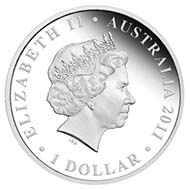October 7th, 2010 – When the Commonwealth of Australia was proclaimed on 1 January 1901, its currency included British gold, silver and bronze coins. Under the new Constitution, the control of currency was vested in the Commonwealth, but it was not until the 1909 Coinage Act that the Government took steps to introduce distinctive Australian coins.
Australia, 1 AUD; 1 oz silver, weigt: 31,135; diameter: 40,60 mm; designer: Darryl Bellotti; mintage: 7.500; date of issue: October 5th, 2010.
Issued in 1911, Australia’s first penny and halfpenny appeared a year later than the nation’s first silver coins. Made by the Royal Mint in England, the obverse portrayed Sir E. B. Mackennal’s effigy of King George V, who had ascended to the throne on the death of his father, King Edward VII, on 6 May 1910.
Struck from 97% copper, 2.5% zinc and 0.5% tin, the bronze coins featured the 1908 Commonwealth Coat of Arms design by W. H. J. Blakemore. The inscriptions ONE PENNY or ONE HALF PENNY appeared inside a beaded inner circle, with the words COMMONWEALTH OF AUSTRALIA shown between the inner circle and the rim.
This commemorative issue is struck from 1oz of 99.9% pure silver in proof quality, and is issued as legal tender under the Australian Currency Act 1965.
Design
The colored reverse of the 2011 commemorative coin portrays King George V and a montage of the first distinctive Australian penny and halfpenny coins. The design also incorporates the inscriptions CENTENARY OF AUSTRALIAN COMMONWEALTH BRONZE COINAGE 1911 – 2011.
The coin’s obverse depicts the Ian Rank-Broadley effigy of Her Majesty Queen Elizabeth II, the 2011 year-date, and the monetary denomination.
If you want to know more about the Perth Mint, click here.
If you want to find interesting facts and figures about Australian monetary history, click here.






